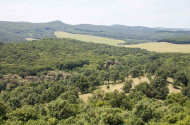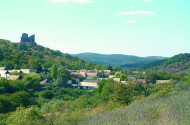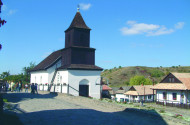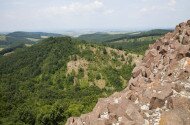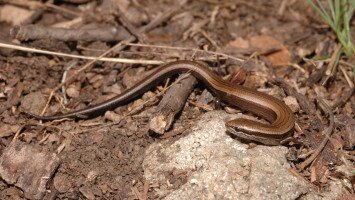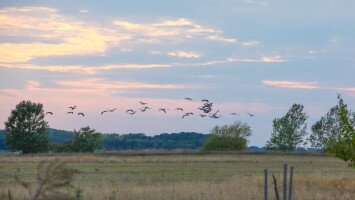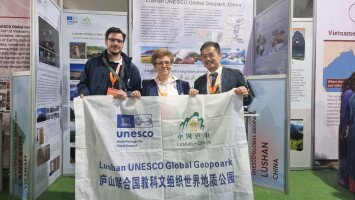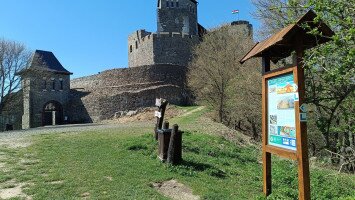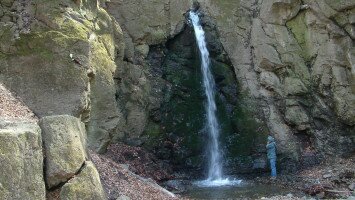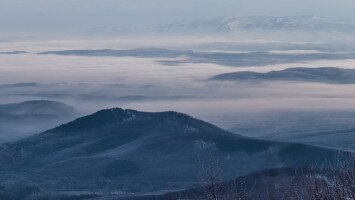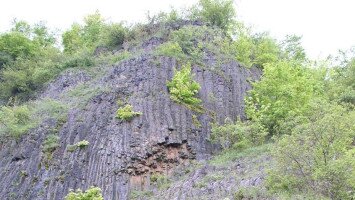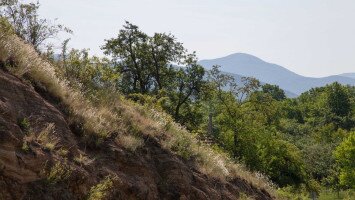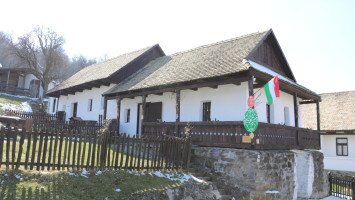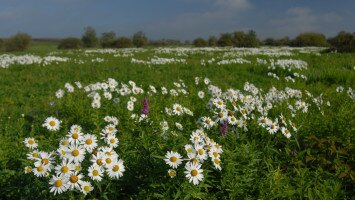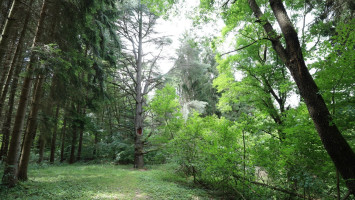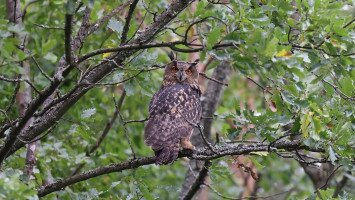
Védetté nyilvánítása: 1977
Területe: 141,2 ha
A tájvédelmi körzet alapadatai
A Hollókői Tájvédelmi Körzetet 1977-ben hozták létre Nógrád megyében, a Központi-Cserhát vulkanikus tömbjének északi részén. A kiemelt természetvédelmi oltalom célja elsősorban a világ kulturális örökségének részét képező palóc kisközség táji környezetének megőrzése. További, előzővel összefüggő célja a terület életközösségeinek és fajainak, földtani és felszínalaktani értékeinek megőrzése. A tájvédelmi körzet területe 141,2 ha.
A tájvédelmi körzet kizárólag Hollókő település közigazgatási területét érinti. 1987-ban az Ófalu és környezete az UNESCO kulturális világörökség részévé vált, melynek területe lényegében megegyezik a tájvédelmi körzet területével.
A terület földrajza
A védett terület a Központi-Cserhát kistáj északi határterületén fekszik, tőle északra a Szécsényi-dombság kistáj terül el.
A környék legmarkánsabb geomorfológiai nagyformái a keskeny, elnyúlt alakú telérek. A miocén kori vulkanizmus során keletkezett andezit kőzetanyaga nagy keménységű, így a telér rövid, meredek lejtőkkel emelkedik ki puha, üledékes kőzetekből álló környezetéből. A kemény andezit közvetlen környezetében a szomszédos, laza mellékkőzeteket is megvédte a lepusztulástól. A legnagyobb méretű (mintegy 2,5 km hosszú) az ún. Hollókői telér, amely északnyugat–délkeleti csapásirányban a Vár-hegy – Gomb-hegy – Szár-hegy vonulatot hordozza. A Vár-hegyet egyes kutatók a teléren kialakult helyi kitörési központnak tartják. A „nagy” telér déli oldalán, egy abból kiágazó, kisebb méretű telér található. Az ezt feltáró kis kőfejtőben jól tanulmányozhatók a telérkőzetek típusjegyei: a vulkáni kőzetanyagban láthatjuk a mellékkőzet zárványait, peremén a hőhatásra megsült mellékkőzeteket.
A Vár-hegy déli lábánál fakadó Vár (Strand)-forrás vize gyengén szénsavas (csevice jellegű forrás) és magas rétegeredetű vas- és mangántartalom jellemzi. A forrás a középkorban a vár és a környék lakói számára biztosított ivóvizet, 1936 és 1965 között a közelében létesített „parasztfürdőt” táplálta, 1960 és 1989 között innen biztosították a falu vezetékes vízellátását.
A tájvédelmi körzetben a legelő művelési ágú területek részesedése a legnagyobb (33%), de ezek jelentős részén erdőtervezett erdők találhatók (beerdősült fás legelők). Az erdő művelési ágú területek 26%-ot tesznek ki. Nagy az Öregszőlő zártkertjének területi részesedése (28%), azonban a korábbi művelést (szőlő, gyümölcs, kert, szántó) már teljesen felhagyták. Az Ófalu belterülete 11%-os részesedéssel van jelen, a külterületi kivett földrészletek pedig 2%-ot tesznek ki.
Társadalmi jellemzők
A tájvédelmi körzet térségére a falvas településszerkezet jellemző, maga Hollókő község 380 fős lakosságával a törpefalvak közé tartozik.
A kis községhatár a múltban sem tudta eltartani teljes mértékben a falu lakosságát, jelenleg is jellemző az ingázás. A növekvő turisztikai kihasználtság mellett is, a hollókői lakosok elsősorban melléktevékenységként vesznek részt a turisztikai szolgáltatásban. A nógrádi törpefalvaknál Hollókő jobb ellátottságú (óvoda, iskola, orvosi rendelő, posta áll rendelkezésre), de a falu elöregedése nem állt még meg.
A turisztikai irányultság és a falu természeti környezetének turisztikai szerepe jelentősen csökkenti a lakosság és a természetvédelmi kezelő közötti konfliktushelyzetek számát. Legfontosabb természetvédelmi problémaként az engedély nélküli hulladéklerakás és off road tevékenység lép fel, utóbbit azonban jellemzően nem a helybéliek végzik.
Gazdálkodás
A tájvédelmi körzet kis mérete, tulajdonviszonyai (nagyrészt állami tulajdon és nemzeti park igazgatósági vagyonkezelés), valamint a védelem céljai folytán a gazdálkodás mértékét és módját nagyban befolyásolja a turisztikai hasznosítás és a táji értékek fenntartása. Az állami tulajdonú erdőkben természetvédelmi erdőkezelés folyik, a kevés magántulajdonú erdő kis gazdasági értéke pedig nem ad lehetőséget komolyabb volumenű erdőgazdálkodásra. A legelőként fennmaradt, illetve a nemzeti park igazgatóság által helyreállított területeket helybéli gazdálkodó hasznosítja húsmarhával történő legeltetéssel. A legelők kis mérete és fűhozama nem teszi lehetővé gazdasági szerepük növelését, azonban a fás legelők fennmaradásához fontos turisztikai érdek is fűződik.
Természeti értékek
Zoológia
A terület kis kiterjedése ellenére, élővilága figyelemre méltó.
A tájvédelmi körzet értékes rovarvilágából megemlítendő a tölgyesekben élő tölgyfaszender (Marumba quercus), illetve az Ófalu gyümölcsfáin előforduló nagy pávaszemes szövő (Saturnia pyri).
A fás legelő idős hagyásfáiban gyakori a nagy hőscincér (Cerambyx cerdo) és a nagy szarvasbogár (Lucanus cervus). Az erdőben található öreg fák tövén kialakult odvakban olyan rovartani értékek jelennek meg, mint a kék pattanóbogár (Limoniscus violaceus) és a párducfoltos hangyaleső (Dendroleon pantherinus). A korhadó (elsősorban földön fekvő) holt faanyagban fejlődik a szőrös szarvasbogár (Aesalus scarabaeoides). Az Öregszőlőkben, a felhagyott szőlők helyén kialakult félszáraz irtásréteken előfordul a védett magyar darázscincér (Chlorophorus hungaricus).
A gerincesek közül kiemelendő a Vár-forrás patakjában szaporodó foltos szalamandra (Salamandra salamandra), a főként üde erdőket kedvelő kékpettyes lábatlangyík (Anguis colchicus), valamint az odúlakó madarakat képviselő fekete harkály (Dryocopus martius), hamvas küllő (Picuscanus), közép fakopáncs (Dendrocopos medius), kék galamb (Columba oenas) és örvös légykapó (Ficedula albicollis). A fás legelő öreg, kiodvasodó fáiban rendszeresen költ a macskabagoly (Strix aluco). A ligetes erdők, felhagyott szőlők fokozottan védett emlőse az erdei pele (Dryomys nitedula). A fokozottan védett vadmacska (Felis sylvestris) szintén előfordul a tájvédelmi körzet területén.
Botanika
Növényföldrajzilag a terület a Pannóniai flóratartomány (Pannonicum) Északi-középhegységi flóravidékének (Matricum) Nógrádi flórajárásához (Neogradense) tartozik.
A Cserhát egyes, jellegzetes növénytársulásainak szép állományaival találkozhatunk itt, így a meredek hegyoldalakon melegkedvelő tölgyesekkel, szilikát-sziklagyepekkel, lejtősztyepprétekkel, a felhagyott szőlők helyén pedig félszáraz irtásrétekkel. A száraz tölgyesekben élő védett növényfajok közül megemlítendő a Nadám-hegyről ismert szubmediterrán pilisi bükköny (Vicia sparsiflora), valamint a vöröslő hagyma (Allium marginatum). A pannon-kárpáti endemikus magyar bogáncs (Carduus collinus) és magyar perje (Poa pannonica subsp. scabra) a Gomb-hegy sziklagyepeiben jelennek meg, együtt a sárga kövirózsával (Jovibarba hirta), amely a várfal tövében is előfordul a sziklákon. A Gomb-hegy szikláin fekete madárbirs (Cotoneaster niger) alkotta sziklai cserjés díszlik.
A Cserhátban ritka üde lomberdei fajok is előfordulnak, így a Vár-hegyen élő évelő holdviola (Lunaria rediviva) a Cserhátban máshonnan nem ismert, az ugyanitt élő kapotnyak (Asarum europaeum) pedig alig néhány további helyen került elő. Ugyancsak cserháti ritkaságnak számít a Hollókői-patak völgyéből előkerült négylevelű farkasszőlő (Paris quadrifolia).
Kultúrtörténeti emlékek
A hollókői Ófalu XVII–XVIII. században kialakított egyszerű formájú, fésűs beépítésben rendeződő, fehérre meszelt házai eredeti állapotukban őrződtek meg napjainkig, s 1987 óta méltán képezik a világ kulturális örökségének részét. Hazánk egyik legkisebb területű tájvédelmi körzetét a palóc kisközség táji környezetének megőrzésére hozták létre: az Ófalut körülölelő dombok visszatükrözik az itt élő emberek életmódját, gazdálkodási szokásait, természetismeretét és -szeretetét.
A Hollókőre utaló első írásos emlékek a település fölé emelkedő 262 méter magas sziklás hegytetőre épült várral és a várbirtokkal kapcsolatosak. A szabálytalan alaprajzú, belsőtornyos várat minden bizonnyal a tatárjárást követően, a XIII. században építtette a Kacsics nemzetség. A vár tornyából csodálatos panoráma tárul elénk: látható az Ipoly völgyének jó része, a salgói vár, az egykori őrhegyek egészen a Karancsig.
A Hollókői-patak völgyének oldalában, az Öregszőlők-dűlőben, lejtésirányban hosszan elnyúló, keskeny szalagparcellákat láthatunk. A területet a történeti térképek tanúsága szerint már a XVIII. században szőlők foglalták el. A domboldal mai képe az 1860-ban lezajlott parcellázáskor alakult ki, amikor a mindössze 50 hektáros területet 687 szalagparcellára osztották. A szőlőkbe ezt követően telepítették a gyümölcsfákat köztes növényként. A meredek, agyagos talajú terület kis hozamokat eredményez, és művelése igen fáradságos munka. A falu lakosságának elöregedésével, a fiatalság elvándorlásával párhuzamosan a parcellák jelentős részét napjainkra felhagyták. A hagyományos, karós művelésű szőlők, valamint az ősi, a kártevőkkel és betegségekkel szemben ellenálló fajtákat őrző gyümölcsösök nagy része elpusztult, már csak néhány öreg példány dacol az idővel. A parlagon maradt parcellák gyomosodnak, cserjésednek. E sajátos termelési rendszer hozzájárult annak a sajátos szerkezetű és kiemelkedő szépségű tájnak a létrejöttéhez, amely – a műemlék falu korhű természeti környezeteként – méltán képezi a tájvédelmi körzet és a világörökségi terület szerves részét.
Az erdei makkoltatás és a gyepek legeltetése között egyfajta átmenetet képvisel a Vár-hegyen és Gomb-hegyen a zárt erdőállomány ritkításával, feltételezhetően a XVIII. században létrehozott hagyásfás legelő hasznosítása. A hatalmas tölgyekkel tarkított ligetes fás terület a XX. század utolsó évtizedeiben a legeltetés megszűnésével csaknem teljesen beerdősült. A Bükki Nemzeti Park Igazgatóság jelentős erőfeszítéseket tesz ennek a kiemelkedő jelentőségű agrártörténeti emléknek és egyben tájképi értéknek a megőrzése érdekében.
A hollókői emberek életének kicsiny, de kultúrtörténeti szempontból jelentős emlékei a Hollókői-patak völgyében megtalálható mosótavak és kenderáztató tavak, valamint a Vár-hegy déli lábánál lévő völgyben a „parasztfürdő” maradványai. Rendszeres használatuk a XX. század második felében szűnt meg.
Gyakorlati természetvédelem
Élőhelykezelések
A tájvédelmi körzetben a nemzeti park igazgatóság saját vagyonkezelésében lévő fás legelőkön 2008-2010 között hajtott végre egy helyreállítási projektet. A projekt során mintegy 19 hektár elcserjésedett/beerdősült fás legelő visszaállítását végezték el, a területek hasznosítását helybéli gazdálkodó végzi haszonbérlet útján. A húsmarhával történő legeltetés mellett rendszeres sarjleverést is igényel a terület, melyet szintén a haszonbérlő végez.
Az inváziós fásszárúak visszaszorítását az Igazgatóság rendszeresen végzi mind gyep-, mind erdőterületeken.
A Bükki Nemzeti Park Igazgatóság saját vagyonkezelésében lévő erdőkben folyó természetvédelmi erdőkezelés célja az erdei biodiverzitás megőrzése, az erdőkben fellépő természetes folyamatok megsegítése, a természetes erdők szerkezeti és funkcionális jellemzőinek helyreállítása. Ezt a célt a Hollókői Tájvédelmi Körzet területén jelenleg nagyrészt a beavatkozások kerülésével, illetve inváziós fajok visszaszorításával végzik. A jövőben jól megtervezett, célirányos kezelési beavatkozásokkal az itteni erdők természetességi állapota tovább javítható.
Kisebb vizes élőhelyek (foltos szalamandra szaporodó helyek) kézi eszközökkel végzett helyreállítására már több esetben sor került a Hollókői-patak mentén.
Fajvédelem
A tájvédelmi körzet legjelentősebb védett és fokozottan védett fajainak megőrzését nagyrészt a fent ismertetett élőhely-kezelések és helyreállítások szolgálják. A fajvédelmi intézkedések egyik legfontosabb részét a saját kezelések idő- és térbeli rendjének kialakítása, illetve (más gazdálkodó, kezelő esetén) az idő- és térbeli korlátozások adják.
Néhány védett madár- és emlősfaj védelmét mesterséges odúk kihelyezésével segíti elő az Igazgatóság.
Természetvédelmi problémák
A természetvédelmi szempontok érvényesülésének egyik fő problémakörét az idegenhonos inváziós fajok jelenléte adja. A legfőbb gondot a fehér akác (Robinia pseudoacacia) jelenléte adja, elsősorban erdei élőhelyeken. A lágyszárúak közül a kanadai aranyvessző szerepe emelhető ki, mint a gyepterületek egyik fő veszélyeztető tényezője.
Elsősorban az erdei élőhelyek biológiai sokféleségének megőrzésére jelent kiemelt veszélyt az utóbbi évtizedre drasztikusan megnőtt nagyvad létszám. A tájvédelmi körzetben a gímszarvas, a vaddisznó és a muflon okoz egyre súlyosodó természetvédelmi problémát.
Az illegális tevékenységek közül a terepi motoros sportok űzése és a hulladéklerakás van a legjelentősebb káros hatással a tájvédelmi körzet természeti állapotára. A gyepgazdálkodással kapcsolatos problémák elsősorban a gyepkezelés hiányában jelentkeznek. A felhagyott Öregszőlőben a természetes szukcessziónak köszönhetően kialakult értékes gyepfoltok a kezelés hiányában fokozatosan beerdősülnek és eltűnnek.
A gyalogos turizmus a terület hasznosításának kiemelt jelentőségű formája, amely veszélyeztető tényezőként (kisméretű érzékeny élőhelyek taposása) csak kis mértékben jelentkezik.
Kutatás, oktatás
A Hollókői Tájvédelmi Körzetet korábban úgy tekintették, hogy csak kultúrtörténeti és tájképi értékei kiemelkedőek, élővilágának természeti értéke nem jelentős. Az utóbbi másfél évtized botanikai és zoológiai felmérései azonban rámutattak, hogy kis mérete ellenére meglehetősen gazdag flórával és faunával rendelkezik. A vizsgálatok nagy részét az Igazgatóság munkatársai végezték, megbízott külsős specialisták csak egy-két rovarcsoport feltárását végezték el. A fás legelőn a Szent István Egyetem kutatói végeztek felméréssorozatot, elsősorban a helyreállítási tevékenységek hatásainak nyomon követésére. A Hollókőn még nagy változatosságban fennmaradt régi gyümölcsfajták felmérését és lementését a Cserhát Natúrpark Közhasznú Alapítvány és a Bükki Nemzeti Park Igazgatóság közösen végzi, pomológus kutatók bevonásával.
A Hollókői Tájvédelmi Körzet természeti értékeinek és a nemzeti park igazgatóság munkájának a bemutatását jelenleg két igazgatósági kezelésű tanösvény és a Tájház segíti.
Az oktatási és szemléletformálási tevékenység rendszeresen végzett formája a tájvédelmi körzetben a terepgyakorlatok, szervezett túrák, iskolai/óvodai foglalkozások tartása.
Látogathatóság
A tájvédelmi körzet teljes területe szabadon látogatható, amelyet több turistaút (köztük az Országos Kék Túra) is segít.
A terület természeti és kultúrtörténeti értékeivel való ismerkedést négy tanösvény segíti. A Vártúra tanösvény a földtani adottságokat, értékeket és a táj történelmét, a Holló (Biológiai) tanösvény a növénytani és állattani adottságokat, értékeket mutatja be, átalakításuk folyamatban van. Külön megálló az andezit telér bemutatóhelye.
A Vár-alja tanösvény a Vár-forrástól a patak mentén lefelé vezet a rimóci útig. Ezen az ösvényen elsősorban a vízhez kötődő élőhelyek élővilágát, valamint a Vár-forrás történetét tanulmányozhatjuk. A Hollókői-patak völgyében kialakított Kertek alja tanösvényen elsősorban a hagyományos népi élet és gazdálkodás emlékeivel ismerkedhetünk meg, de az élővilágot bemutató elemek is részét képezik.
A Bükki Nemzeti Park Igazgatóság vagyonkezelésében lévő Tájház több évtizede látogatható az Ófaluban, benne kapott helyet a „Táj és nép” című táj- és településtörténeti kiállítás. Jelenleg, az épület romló állapota és üzemeltetési nehézségek miatt csak korlátozott időszakokra biztosított a nyitvatartása. A Tájház épületének felújítása és a kiállítás korszerűsítése az Igazgatóság rövid távú tervei között szerepel.
Elérhetőség
Bükki Nemzeti Park Igazgatóság: 3304 Eger, Sánc u. 6. tel: 36/411-581; e-mail: titkarsag@bnpi.hu
Nógrád-Ipoly Természetvédelmi Tájegység Területkezelési Központja: 3067 Garáb 66 hrsz, e-mail: nite@bnpi.hu
Letölthető anyagok:
148/2007. (XII. 27.) KvVM rendelet a Hollókői Tájvédelmi Körzet védettségének fenntartásáról
